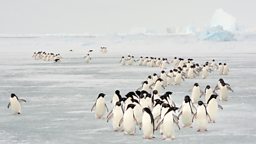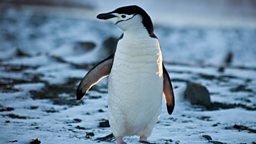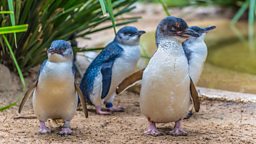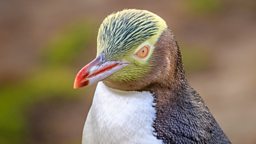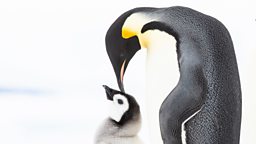How many penguins are there?
By Emily Miller, Assistant Producer for Penguins: Meet the Family
You might think the answer to ‘how many species of penguins are there’ would be simple… but its not.
In fact, you may well have just stumbled into the most contentious issue in the world of penguin science.

Southern rockhopper
Traditionally the number of worldwide penguin species has been listed as 17.
These include: the Snares penguin, Galápagos penguin, African penguin, Adélie penguin, Humboldt penguin, rockhopper penguin, emperor penguin, royal penguin, macaroni penguin, gentoo penguin, Fiordland penguin, chinstrap penguin, king penguin, little blue/fairy penguin, yellow eyed penguin, Magellanic penguin and the erect crested penguin.
But then in 2006, the rockhopper penguin began to be recognised as two different species, the southern rockhopper penguin (Eudyptes chrysocome) and the northern rockhopper penguin (Eudyptes moseleyi). Though even this is still under debate by some.
So the currently recognised total of penguin species (by the IUCN and other scientific organisations) stands at 18.
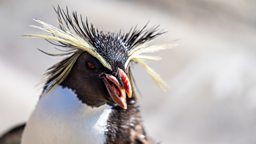
Northern rockhopper
So the currently recognised total of penguin species (by the IUCN and other scientific organisations) stands at 18.
So the currently recognised total of penguin species (by the IUCN and other scientific organisations) stands at 18.
However, scientists around the world have begun to look more closely at other penguins and realised that perhaps there are more species or sub-species too…
But how do you even define a species?
In biology this is often defined by a group of organisms that share characteristics and are capable of interbreeding. Sounds simple enough, but evolution is ongoing, and nature does not always follow the same rules that humans have set out. To make matters more confusing, different penguin species are known to interbreed with one another, and in many cases can look almost identical. As technologies advance and our understanding and application of DNA becomes better this can cause disagreements between scientists.
In fact, in the field of science there are more than 20 different species concepts including: the ecological species concept (where a species is defined by the resources a group of organisms depend on) and the genetic species concept (which looks more at genetic differences between different populations.
In fact, in the field of science there are more than 20 different species concepts
For example, evolutionary biologist Dr Theresa Cole from the Department of Biology at the University of Copenhagen uses genomics and skeletal morphology to identify when and where new species emerge in penguin evolutionary history. In 2019 she teamed up with colleagues in New Zealand and the USA, and using ancient DNA and morphology, described two recently extinct penguins from New Zealand fossil records. Her research advocates splitting the southern rockhopper penguin into two species (eastern and western). She also suggests that evidence shows the little penguin should be considered two species. Dr Cole’s current work aims to help provide new clues to these dilemmas.
Then there is Dr Jane Younger from the Milner Centre for Evolution at the University of Bath who recently has a paper published suggesting there may be four species of Gentoo penguin, rather than the currently categorised one. Dr Younger’s study used an ‘integrative taxonomic approach’ where evidence was combined from genomics and morphology to show how genetically different each potential species of Gentoo was. According to the new evidence the birds differ in size and shape and can be told apart by their differing DNA.
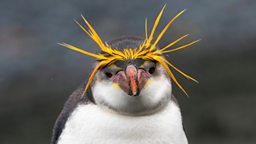
Royal penguin
...there is a lot more to these spectacular seabirds than meets the eye.
There is also a longstanding scientific question over whether royal and macaroni penguins are two separate species or if the royal is a subspecies of the macaroni. Again this is a divisive debate that is still up for discussion.
But why is it important to know how many species there are? Well, counting penguins as different species could help with conservation as it would make it easier to catch and monitor population declines. Penguins face various threats in the wild from overfishing and climate change to plastic pollution so it is important to check the health of individual colonies.
So the current, widely recognised total currently sits at 18 species, but that could change in the next couple of years. No matter which side of the iceberg you sit on it is clear there is still much debate to be had in the world of penguin species science. Which just goes to show there is a lot more to these spectacular seabirds than meets the eye.
